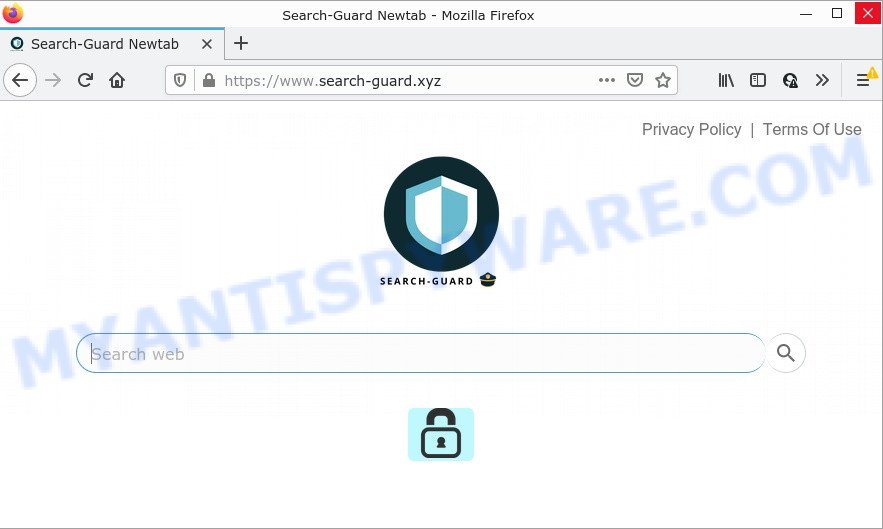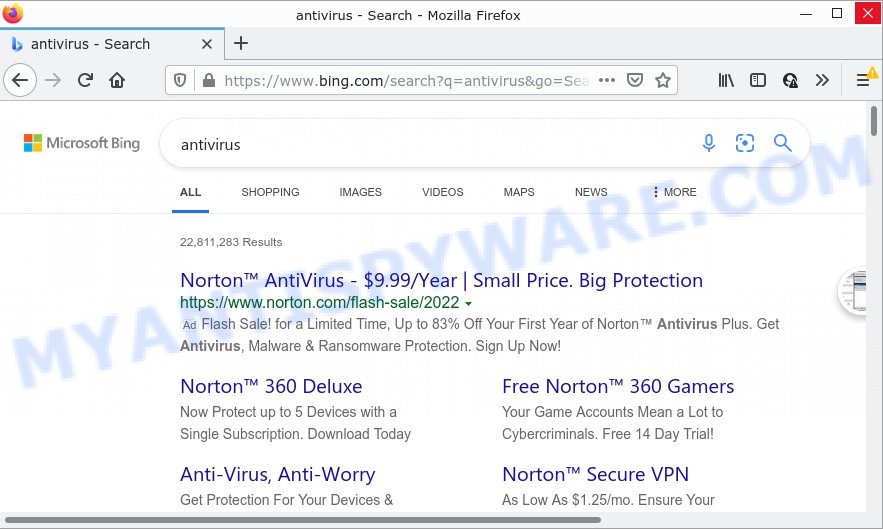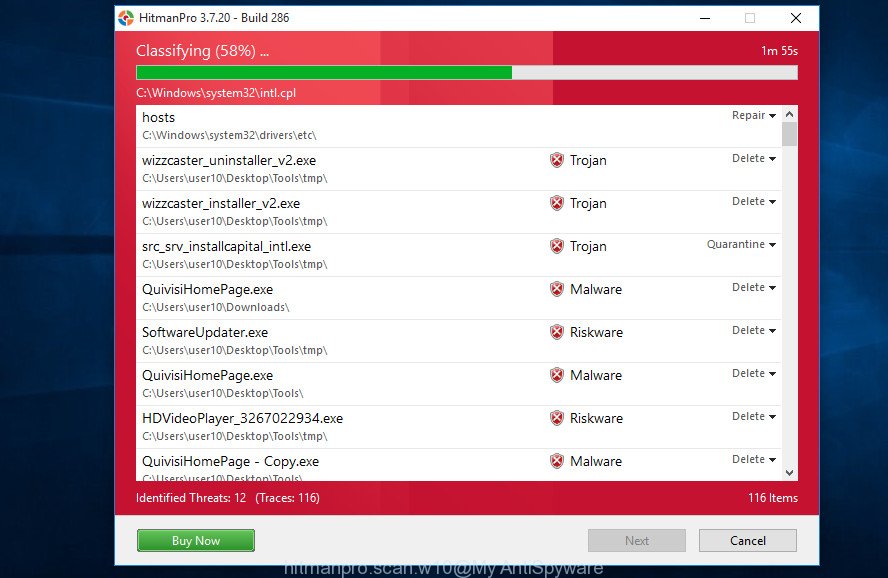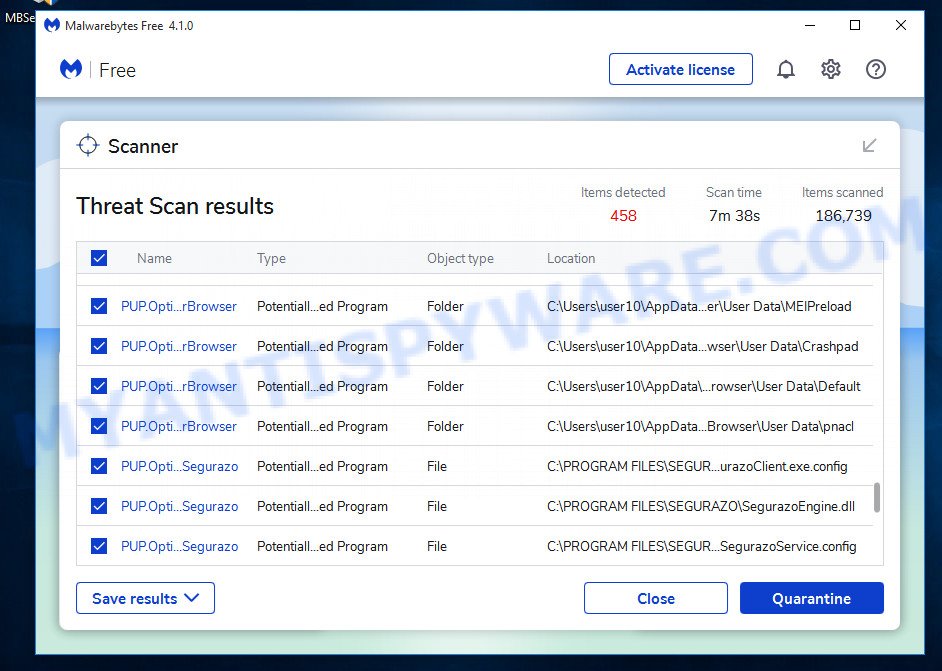What is Search-Guard?
The computer security specialists have determined that Search-Guard is a potentially unwanted program (PUP) from the group of Browser hijackers. Browser hijacker is a kind of software that is created to change the web-browser settings without the knowledge or permission of the computer user, and it usually redirects the affected system’s web browser to certain advertisement-related web-sites. A browser hijacker redirects user web searches to its own web site, initiates numerous pop-ups, generates multiple pop-up ads, alters the default internet browser search engine or start page and installs multiple toolbars on the browser. If your internet browser is affected by a browser hijacker you may need to perform manual steps or use a malware removal tool to revert changes made to your internet browsers.

Most often, browser hijackers promote fake search providers by setting their address as the default search provider. In this case, the hijacker installs search-guard.xyz as a search provider. This means that users whose web browser is infected with the browser hijacker are forced to visit search-guard.xyz each time they search in the Net, open a new window or tab. And since search-guard.xyz is not a real search provider and does not have the ability to find the information users need, this web-site redirects the user’s web-browser to the Bing search engine.

Search-Guard redirects user seaches to Bing
Another reason why you need to get rid of Search-Guard is its online data-tracking activity. It can gather personal information, including:
- IP addresses;
- URLs visited;
- search queries/terms;
- clicks on links and advertisements;
- internet browser version information.
How can a browser hijacker get on your device
Browser hijackers and potentially unwanted programs such as Search-Guard come from web browser toolbars, web browser extensions, BHOs (browser helper objects) and bundled software. Most often, these items claim itself as applications which improve your experience on the Net by providing a fast and interactive home page or a search engine that does not track you. Remember, how to avoid the unwanted software. Be cautious, start only reputable applications which download from reputable sources. NEVER install an unknown and suspicious program.
Threat Summary
| Name | Search-Guard |
| Type | redirect virus, browser hijacker, PUP, homepage hijacker, search provider hijacker |
| Affected Browser Settings | startpage, search engine, new tab URL |
| Related domains | search-guard.xyz |
| Distribution | suspicious popup advertisements, free programs setup files, fake update tools |
| Symptoms | You experience a lot of of unexpected advertising pop ups. When you go to a web-page, you’re occasionally redirected to another web-site that you do not intend to visit. New entries appear in your Programs folder. Unwanted web-browser toolbars on your desktop. Your web-browser search engine has changed without your permission. |
| Removal | Search-Guard removal guide |
How to remove Search-Guard from Chrome, Firefox, IE, Edge
When a hijacker like Search-Guard gets installed on your personal computer without your knowledge, it’s not easy to delete. In many cases, there is no Uninstall program that simply uninstall it from your device. So, we recommend using several well-proven free removal tools such as Zemana, MalwareBytes or Hitman Pro. But the best method to remove the browser hijacker will be to perform some manual steps, after that additionally run free malware removal tools.
To remove Search-Guard, follow the steps below:
- How to manually delete Search-Guard
- Automatic Removal of Search-Guard
- How to stop Search-Guard redirect
How to manually delete Search-Guard
The useful removal guide for Search-Guard. The detailed procedure can be followed by anyone as it really does take you step-by-step. If you follow this process to remove the browser hijacker let us know how you managed by sending us your comments please.
Uninstall Search-Guard related programs through the Control Panel of your computer
We suggest that you begin the PC system cleaning process by checking the list of installed programs and delete all unknown or questionable apps. This is a very important step, as mentioned above, very often the malicious programs such as adware software and hijackers may be bundled with free software. Remove the unwanted apps can remove the unwanted advertisements or web-browser redirect.
Windows 10, 8.1, 8
Click the Microsoft Windows logo, and then click Search ![]() . Type ‘Control panel’and press Enter like below.
. Type ‘Control panel’and press Enter like below.

Once the ‘Control Panel’ opens, press the ‘Uninstall a program’ link under Programs category as shown in the figure below.

Windows 7, Vista, XP
Open Start menu and select the ‘Control Panel’ at right as displayed on the screen below.

Then go to ‘Add/Remove Programs’ or ‘Uninstall a program’ (Microsoft Windows 7 or Vista) as shown in the following example.

Carefully browse through the list of installed programs and get rid of all suspicious and unknown programs. We recommend to click ‘Installed programs’ and even sorts all installed programs by date. When you have found anything questionable that may be the Search-Guard hijacker or other PUP (potentially unwanted program), then select this program and click ‘Uninstall’ in the upper part of the window. If the suspicious application blocked from removal, then run Revo Uninstaller Freeware to completely remove it from your PC system.
Delete Search-Guard browser hijacker from Mozilla Firefox
If Firefox home page or search provider are hijacked by Search-Guard, your internet browser shows unwanted popup advertisements, then ‘Reset Firefox’ could solve these problems. However, your saved passwords and bookmarks will not be changed, deleted or cleared.
Start the Firefox and click the menu button (it looks like three stacked lines) at the top right of the browser screen. Next, click the question-mark icon at the bottom of the drop-down menu. It will show the slide-out menu.

Select the “Troubleshooting information”. If you are unable to access the Help menu, then type “about:support” in your address bar and press Enter. It bring up the “Troubleshooting Information” page as displayed on the image below.

Click the “Refresh Firefox” button at the top right of the Troubleshooting Information page. Select “Refresh Firefox” in the confirmation prompt. The Mozilla Firefox will start a procedure to fix your problems that caused by the Search-Guard browser hijacker. After, it is finished, click the “Finish” button.
Delete Search-Guard hijacker from Internet Explorer
The Microsoft Internet Explorer reset is great if your browser is hijacked or you’ve unwanted extensions or toolbars on your web browser, which installed by a malware.
First, launch the Microsoft Internet Explorer, click ![]() ) button. Next, click “Internet Options” as displayed on the screen below.
) button. Next, click “Internet Options” as displayed on the screen below.

In the “Internet Options” screen select the Advanced tab. Next, press Reset button. The Internet Explorer will show the Reset Internet Explorer settings prompt. Select the “Delete personal settings” check box and click Reset button.

You will now need to restart your computer for the changes to take effect. It will remove Search-Guard hijacker, disable malicious and ad-supported web browser’s extensions and restore the Internet Explorer’s settings like new tab, search engine by default and home page to default state.
Remove Search-Guard from Chrome
Reset Google Chrome settings can help you solve some problems caused by hijacker and remove unwanted search provider, home page and newtab page. This will also disable malicious addons as well as clear cookies and site data. However, your saved bookmarks and passwords will not be lost. This will not affect your history, passwords, bookmarks, and other saved data.
Open the Google Chrome menu by clicking on the button in the form of three horizontal dotes (![]() ). It will show the drop-down menu. Choose More Tools, then click Extensions.
). It will show the drop-down menu. Choose More Tools, then click Extensions.
Carefully browse through the list of installed extensions. If the list has the extension labeled with “Installed by enterprise policy” or “Installed by your administrator”, then complete the following tutorial: Remove Google Chrome extensions installed by enterprise policy otherwise, just go to the step below.
Open the Chrome main menu again, press to “Settings” option.

Scroll down to the bottom of the page and click on the “Advanced” link. Now scroll down until the Reset settings section is visible, as displayed in the following example and click the “Reset settings to their original defaults” button.

Confirm your action, press the “Reset” button.
Automatic Removal of Search-Guard
In order to remove the browser hijacker fully, you not only need to delete it from the internet browsers, but also remove all its components in your PC system including Windows registry entries. We suggest to download and run free removal utilities to automatically free your PC of Search-Guard.
Use Zemana AntiMalware to remove Search-Guard hijacker
If you need a free utility that can easily detect and get rid of Search-Guard hijacker, then use Zemana. This is a very handy application, which is primarily designed to quickly locate and remove adware and malicious software affecting internet browsers and changing their settings.

- Download Zemana Anti-Malware on your computer from the following link.
Zemana AntiMalware
164752 downloads
Author: Zemana Ltd
Category: Security tools
Update: July 16, 2019
- After downloading is complete, close all applications and windows on your computer. Open a file location. Double-click on the icon that’s named Zemana.AntiMalware.Setup.
- Further, click Next button and follow the prompts.
- Once setup is done, press the “Scan” button to detect Search-Guard browser hijacker. While the Zemana is scanning, you can see how many objects it has identified either as being malware.
- As the scanning ends, Zemana AntiMalware will display you the results. Make sure all items have ‘checkmark’ and press “Next”. When disinfection is done, you can be prompted to reboot your PC.
Use HitmanPro to remove Search-Guard from the computer
HitmanPro is a free utility which can identify Search-Guard browser hijacker. It is not always easy to locate all the junk programs that your personal computer might have picked up on the Internet. Hitman Pro will scan for the adware, browser hijackers and other malware you need to remove.

- Click the following link to download the latest version of Hitman Pro for Windows. Save it to your Desktop so that you can access the file easily.
- Once downloading is finished, run the Hitman Pro, double-click the HitmanPro.exe file.
- If the “User Account Control” prompts, click Yes to continue.
- In the HitmanPro window, press the “Next” to perform a system scan for the Search-Guard browser hijacker. This task can take some time, so please be patient.
- After the scan is finished, HitmanPro will open a screen which contains a list of malware that has been found. In order to remove all items, simply click “Next”. Now, click the “Activate free license” button to start the free 30 days trial to remove all malware found.
How to remove Search-Guard with MalwareBytes
We recommend using the MalwareBytes AntiMalware which are fully clean your PC system of the hijacker. The free tool is an advanced malware removal program created by (c) Malwarebytes lab. This application uses the world’s most popular antimalware technology. It’s able to help you remove hijacker, potentially unwanted programs, malware, adware, toolbars, ransomware and other security threats from your PC system for free.

- First, please go to the following link, then click the ‘Download’ button in order to download the latest version of MalwareBytes Anti-Malware.
Malwarebytes Anti-malware
327018 downloads
Author: Malwarebytes
Category: Security tools
Update: April 15, 2020
- When downloading is complete, close all apps and windows on your computer. Open a folder in which you saved it. Double-click on the icon that’s named MBsetup.
- Choose “Personal computer” option and press Install button. Follow the prompts.
- Once installation is complete, click the “Scan” button to find the Search-Guard hijacker. While the tool is checking, you can see count of objects and files has already scanned.
- After MalwareBytes Anti-Malware has completed scanning, MalwareBytes will display a list of detected items. All detected items will be marked. You can remove them all by simply click “Quarantine”. After the task is complete, you can be prompted to reboot your device.
The following video offers a step-by-step guidance on how to remove browser hijackers, adware software and other malware with MalwareBytes.
How to stop Search-Guard redirect
To put it simply, you need to use an ad-blocking tool (AdGuard, for example). It will stop and protect you from all unwanted web-pages such as Search-Guard, ads and pop ups. To be able to do that, the adblocker program uses a list of filters. Each filter is a rule that describes a malicious website, an advertising content, a banner and others. The adblocker application automatically uses these filters, depending on the webpages you are visiting.
Download AdGuard on your personal computer by clicking on the following link.
26829 downloads
Version: 6.4
Author: © Adguard
Category: Security tools
Update: November 15, 2018
After downloading it, double-click the downloaded file to run it. The “Setup Wizard” window will show up on the computer screen as displayed in the following example.

Follow the prompts. AdGuard will then be installed and an icon will be placed on your desktop. A window will show up asking you to confirm that you want to see a quick guide as shown below.

Click “Skip” button to close the window and use the default settings, or click “Get Started” to see an quick guidance that will assist you get to know AdGuard better.
Each time, when you start your computer, AdGuard will start automatically and stop unwanted advertisements, block Search-Guard redirects, as well as other malicious or misleading webpages. For an overview of all the features of the application, or to change its settings you can simply double-click on the AdGuard icon, that is located on your desktop.
Finish words
Once you have removed the hijacker using the guide, Mozilla Firefox, Internet Explorer, Google Chrome and Edge will no longer open the Search-Guard website on startup. Unfortunately, if the step-by-step tutorial does not help you, then you have caught a new hijacker, and then the best way – ask for help.
Please create a new question by using the “Ask Question” button in the Questions and Answers. Try to give us some details about your problems, so we can try to help you more accurately. Wait for one of our trained “Security Team” or Site Administrator to provide you with knowledgeable assistance tailored to your problem with the browser hijacker.




















